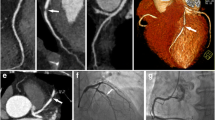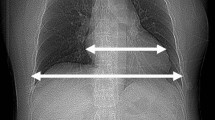Abstract
Purpose
We investigated the effects of patient- and image acquisition-related factors on the image quality in coronary CT angiography (CCTA).
Materials and methods
We enrolled 1197 patients (728 men; 65 ± 12 years). All underwent CCTA under the routine scan protocol in 23 participating hospitals. The subjective image quality (3-point Likert scale: excellent, good, and poor) and the attenuation of the left and right coronary artery (LCA, RCA) were recorded; the effects of patient and image acquisition-related factors on vascular attenuation were then compared.
Results
The mean LCA attenuation was 515.2 ± 65.8 (excellent), 401.4 ± 63.4 (good), and 319.5 ± 47.6 HU (poor). The corresponding RCA attenuation was 496.6 ± 67.6, 390.5 ± 58.5, and 308.5 ± 50.7 HU, respectively. Univariate analysis revealed significant associations between sufficient coronary attenuation (> 400 HU) and the age, gender, body surface area (BSA), number of detectors, contrast synchronization, scan mode, and the fractional contrast dose. Multivariate analysis revealed that the bolus tracking method, prospective electrocardiogram gating, and fractional contrast dose were significantly associated with sufficient coronary enhancement.
Conclusion
BSA and fractional contrast dose are the most important patient- and image acquisition-related factors for sufficient coronary attenuation in CCTA.




Similar content being viewed by others
References
Mowatt G, Cook JA, Hillis GS, Walker S, Fraser C, Jia X, et al. 64-Slice computed tomography angiography in the diagnosis and assessment of coronary artery disease: systematic review and meta-analysis. Heart. 2008;94:1386–93.
Pontone G, Andreini D, Bartorelli AL, Cortinovis S, Mushtaq S, Bertella E, et al. Diagnostic accuracy of coronary computed tomography angiography: a comparison between prospective and retrospective electrocardiogram triggering. J Am Coll Cardiol. 2009;54:346–55.
Min JK, Shaw LJ, Devereux RB, Okin PM, Weinsaft JW, Russo DJ, et al. Prognostic value of multidetector coronary computed tomographic angiography for prediction of all-cause mortality. J Am Coll Cardiol. 2007;50:1161–70.
Konishi M, Sugiyama S, Sugamura K, Nozaki T, Ohba K, Matsubara J, et al. Total coronary artery plaque burden measured by cardiac computed tomography is associated with metabolic syndrome. J Atheroscler Thromb. 2011;18:939–45.
Motoyama S, Sarai M, Narula J, Ozaki Y. Coronary CT angiography and high-risk plaque morphology. Cardiovasc Interv Ther. 2013;28:1–8.
Utsunomiya D, Oda S, Yuki H, Yamamuro M, Tsujita K, Funama Y, et al. Evaluation of appropriateness of second-generation 320-row computed tomography for coronary artery disease. SpringerPlus. 2015;4:109.
Toepker M, Euller G, Unger E, Weber M, Kienzl D, Herold CJ, et al. Stenosis quantification of coronary arteries in coronary vessel phantoms with second-generation dual-source CT: influence of measurement parameters and limitations. AJR Am J Roentgenol. 2013;201:W227–34.
Gaur S, Bezerra HG, Lassen JF, Christiansen EH, Tanaka K, Jensen JM, et al. Fractional flow reserve derived from coronary CT angiography: variation of repeated analyses. J Cardiovasc Comput Tomogr. 2014;8:307–14.
Norgaard BL, Leipsic J, Gaur S, Seneviratne S, Ko BS, Ito H, et al. Diagnostic performance of noninvasive fractional flow reserve derived from coronary computed tomography angiography in suspected coronary artery disease: the NXT trial (analysis of coronary blood flow using CT angiography: next steps). J Am Coll Cardiol. 2014;63:1145–55.
Leber AW, Becker A, Knez A, von Ziegler F, Sirol M, Nikolaou K, et al. Accuracy of 64-slice computed tomography to classify and quantify plaque volumes in the proximal coronary system: a comparative study using intravascular ultrasound. J Am Coll Cardiol. 2006;47:672–7.
Utsunomiya D, Fukunaga T, Oda S, Awai K, Nakaura T, Urata J, et al. Multidetector computed tomography evaluation of coronary plaque morphology in patients with stable angina. Heart Vessel. 2011;26:392–8.
Nakazato R, Gransar H, Berman DS, Cheng VY, Lin FY, Achenbach S, et al. Relationship of low- and high-density lipoproteins to coronary artery plaque composition by CT angiography. J Cardiovasc Comput Tomogr. 2013;7:83–90.
Yamamoto H, Kitagawa T, Ohashi N, Utsunomiya H, Kunita E, Oka T, et al. Noncalcified atherosclerotic lesions with vulnerable characteristics detected by coronary CT angiography and future coronary events. J Cardiovasc Comput Tomogr. 2013;7:192–9.
Yamamuro M, Tadamura E, Kanao S, Wu YW, Tambara K, Komeda M, et al. Coronary angiography by 64-detector row computed tomography using low dose of contrast material with saline chaser: influence of total injection volume on vessel attenuation. J Comput Assist Tomogr. 2007;31:272–80.
Kidoh M, Nakaura T, Nakamura S, Awai K, Utsunomiya D, Namimoto T, et al. Novel contrast-injection protocol for coronary computed tomographic angiography: contrast-injection protocol customized according to the patient’s time-attenuation response. Heart Vessel. 2014;29:149–55.
Hausleiter J, Meyer TS, Martuscelli E, Spagnolo P, Yamamoto H, Carrascosa P, et al. Image quality and radiation exposure with prospectively ECG-triggered axial scanning for coronary CT angiography: the multicenter, multivendor, randomized PROTECTION-III study. JACC Cardiovasc Imaging. 2012;5:484–93.
Du Bois D, Du Bois EF. A formula to estimate the approximate surface area if height and weight be known. 1916. Nutrition. 1989;5:303–11.
LaBounty TM, Kim RJ, Lin FY, Budoff MJ, Weinsaft JW, Min JK. Diagnostic accuracy of coronary computed tomography angiography as interpreted on a mobile handheld phone device. JACC Cardiovasc Imaging. 2010;3:482–90.
Budoff MJ, Dowe D, Jollis JG, Gitter M, Sutherland J, Halamert E, et al. Diagnostic performance of 64-multidetector row coronary computed tomographic angiography for evaluation of coronary artery stenosis in individuals without known coronary artery disease: results from the prospective multicenter ACCURACY (assessment by coronary computed tomographic angiography of individuals undergoing invasive coronary angiography) trial. J Am Coll Cardiol. 2008;52:1724–32.
Meijboom WB, Meijs MF, Schuijf JD, Cramer MJ, Mollet NR, van Mieghem CA, et al. Diagnostic accuracy of 64-slice computed tomography coronary angiography: a prospective, multicenter, multivendor study. J Am Coll Cardiol. 2008;52:2135–44.
Hulten EA, Carbonaro S, Petrillo SP, Mitchell JD, Villines TC. Prognostic value of cardiac computed tomography angiography: a systematic review and meta-analysis. J Am Coll Cardiol. 2011;57:1237–47.
Cademartiri F, Mollet NR, Lemos PA, Saia F, Midiri M, de Feyter PJ, et al. Higher intracoronary attenuation improves diagnostic accuracy in MDCT coronary angiography. AJR Am J Roentgenol. 2006;187:W430–3.
Isogai T, Jinzaki M, Tanami Y, Kusuzaki H, Yamada M, Kuribayashi S. Body weight-tailored contrast material injection protocol for 64-detector row computed tomography coronary angiography. Jpn J Radiol. 2011;29:33–8.
Fei X, Du X, Yang Q, Shen Y, Li P, Liao J, et al. 64-MDCT coronary angiography: phantom study of effects of vascular attenuation on detection of coronary stenosis. AJR Am J Roentgenol. 2008;191:43–9.
Cademartiri F, Nieman K, van der Lugt A, Raaijmakers RH, Mollet N, Pattynama PM, et al. Intravenous contrast material administration at 16-detector row helical CT coronary angiography: test bolus versus bolus-tracking technique. Radiology. 2004;233:817–23.
Fleischmann D. How to design injection protocols for multiple detector-row CT angiography (MDCTA). Eur Radiol. 2005;15(Suppl 5):E60–5.
Bae KT, Seeck BA, Hildebolt CF, Tao C, Zhu F, Kanematsu M, et al. Contrast enhancement in cardiovascular MDCT: effect of body weight, height, body surface area, body mass index, and obesity. AJR Am J Roentgenol. 2008;190:777–84.
Yanaga Y, Awai K, Nakaura T, Utsunomiya D, Oda S, Hirai T, et al. Contrast material injection protocol with the dose adjusted to the body surface area for MDCT aortography. AJR Am J Roentgenol. 2010;194:903–8.
Sawyer M, Ratain MJ. Body surface area as a determinant of pharmacokinetics and drug dosing. Invest New Drugs. 2001;19:171–7.
Ichihara E, Hotta K, Takigawa N, Kudo K, Kato Y, Honda Y, et al. Impact of physical size on gefitinib efficacy in patients with non-small cell lung cancer harboring EGFR mutations. Lung Cancer. 2013;81:435–9.
de Simone G, Devereux RB, Daniels SR, Mureddu G, Roman MJ, Kimball TR, et al. Stroke volume and cardiac output in normotensive children and adults. Assessment of relations with body size and impact of overweight. Circulation. 1997;95:1837–43.
Jinzaki M, Okabe T, Endo A, Kawamura A, Koga S, Yamada M, et al. Detection of attenuated plaque in stable angina with 64-multidetector computed tomography. Circ J. 2012;76:1182–9.
Oda S, Utsunomiya D, Yuki H, Kai N, Hatemura M, Funama Y, et al. Low contrast and radiation dose coronary CT angiography using a 320-row system and a refined contrast injection and timing method. J Cardiovasc Comput Tomogr. 2015;9:19–27.
Leiner T, Abbara S. Contrast injection protocols: it is time to get creative! J Cardiovasc Comput Tomogr. 2015;9:28–30.
Acknowledgments
This study was funded by Bayer Yakuhin Ltd. The study data was independently analyzed and interpreted from the funder.
Author information
Authors and Affiliations
Corresponding author
Ethics declarations
Conflicts of interest
None.
Appendix
Appendix
The participating hospitals are Ehime University Hospital; Fukushima Medical University Hospital; Hamamatsu University Hospital; Hirosaki University School of Medicine and Hospital; Hokkaido University Hospital; Hyogo College Of Medicine Hospital; Iwate Medical University Hospital Memorial Heart Center; Jichi Medical University Hospital; Juntendo University Urayasu Hospital; Kanazawa Medical University Hospital; Kanazawa University Hospital; Kobe University Hospital; Kumamoto University Hospital; Nagoya City University Hospital; Nara Medical University Hospital; Niigata University Medical and Dental Hospital; Saitama International Medical Center; St Marianna University School of Medicine Hospital; The University of Tokyo Hospital; Tottori University Hospital; University of the Ryukyus Hospital; Yamagata University Hospital; and Yamaguchi University Hospital.
About this article
Cite this article
Utsunomiya, D., Tanaka, R., Yoshioka, K. et al. Relationship between diverse patient body size- and image acquisition-related factors, and quantitative and qualitative image quality in coronary computed tomography angiography: a multicenter observational study . Jpn J Radiol 34, 548–555 (2016). https://doi.org/10.1007/s11604-016-0556-0
Received:
Accepted:
Published:
Issue Date:
DOI: https://doi.org/10.1007/s11604-016-0556-0




